2023年中考英语语法归纳冠词课件(共35张PPT)
文档属性
| 名称 | 2023年中考英语语法归纳冠词课件(共35张PPT) | 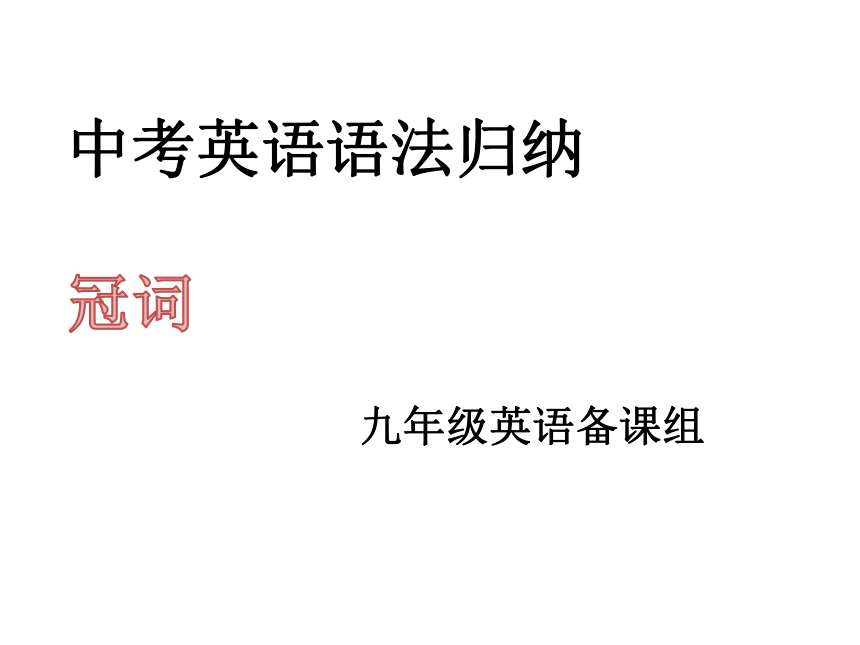 | |
| 格式 | zip | ||
| 文件大小 | 98.6KB | ||
| 资源类型 | 教案 | ||
| 版本资源 | 人教新目标(Go for it)版 | ||
| 科目 | 英语 | ||
| 更新时间 | 2022-07-27 22:54:06 | ||
图片预览

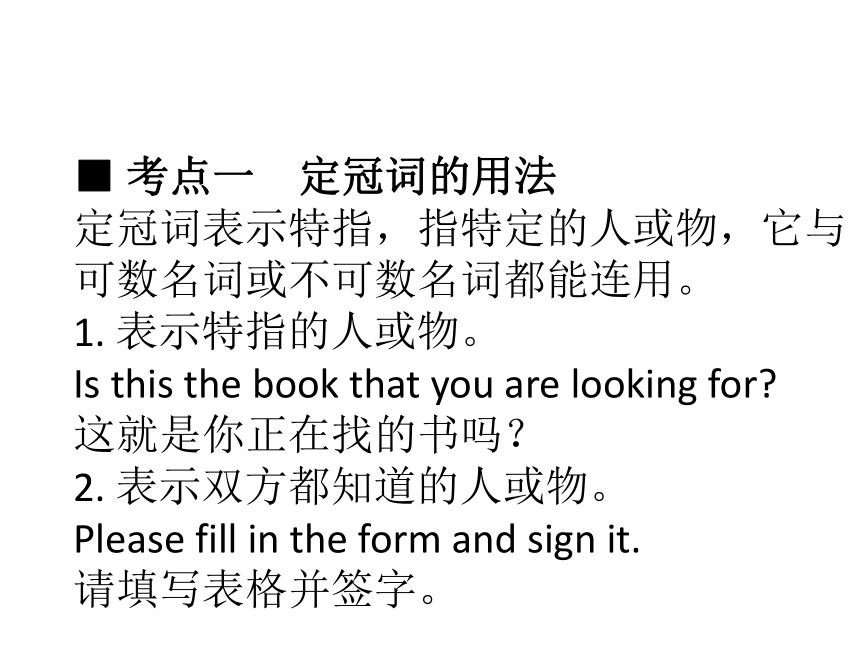
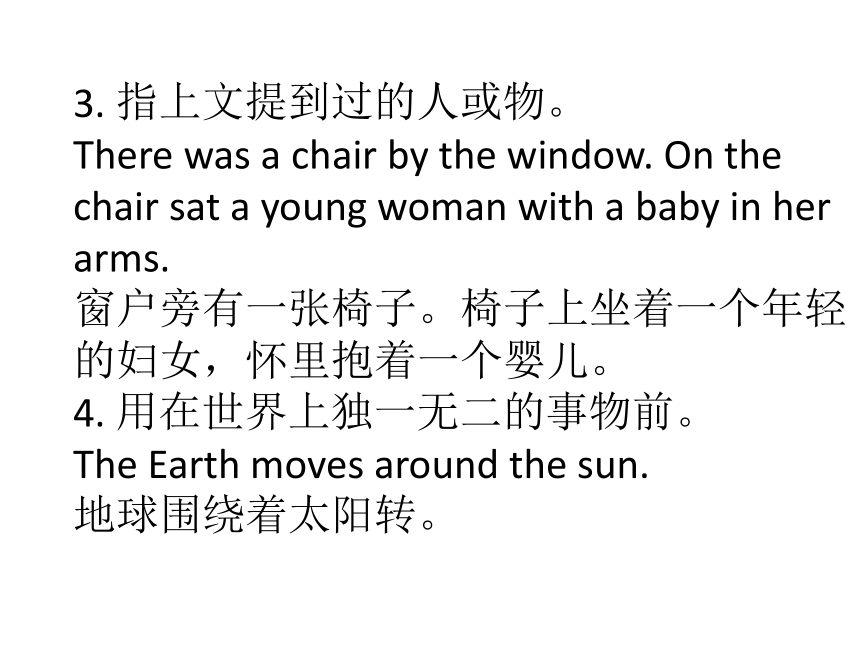
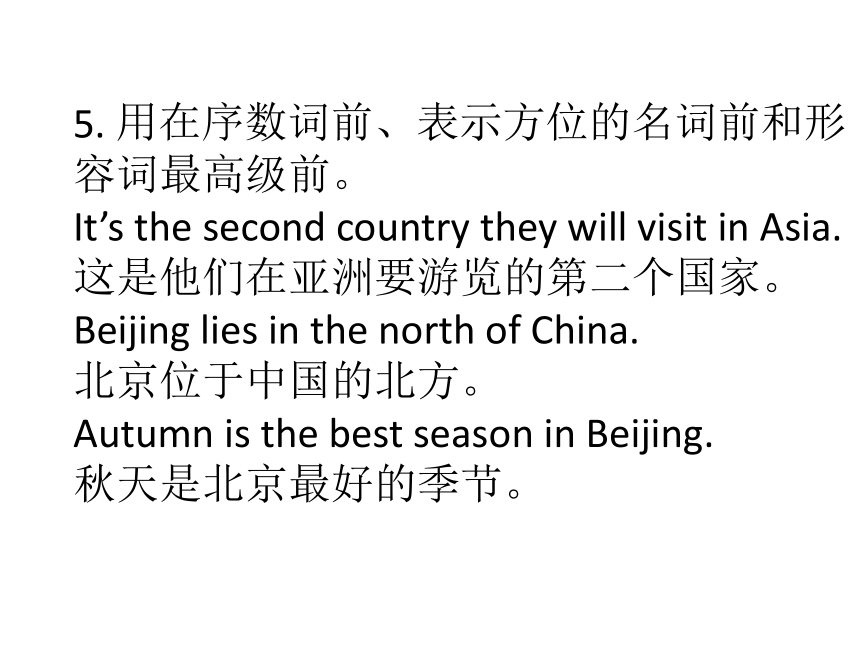
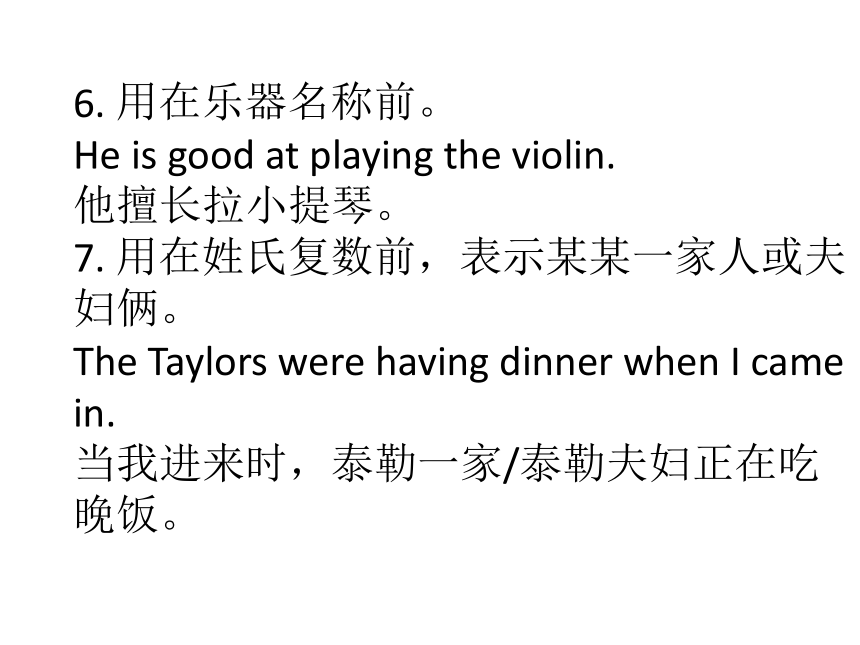
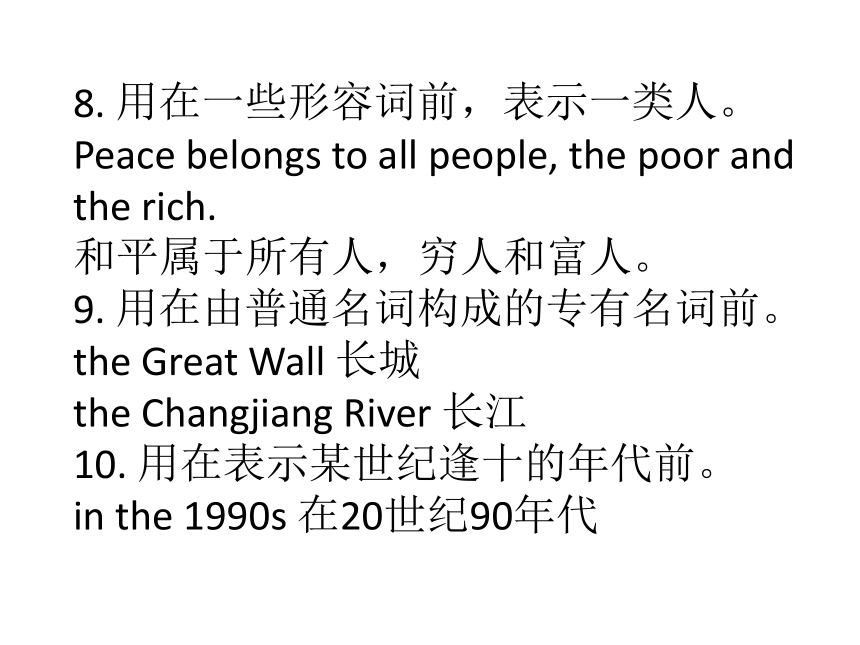

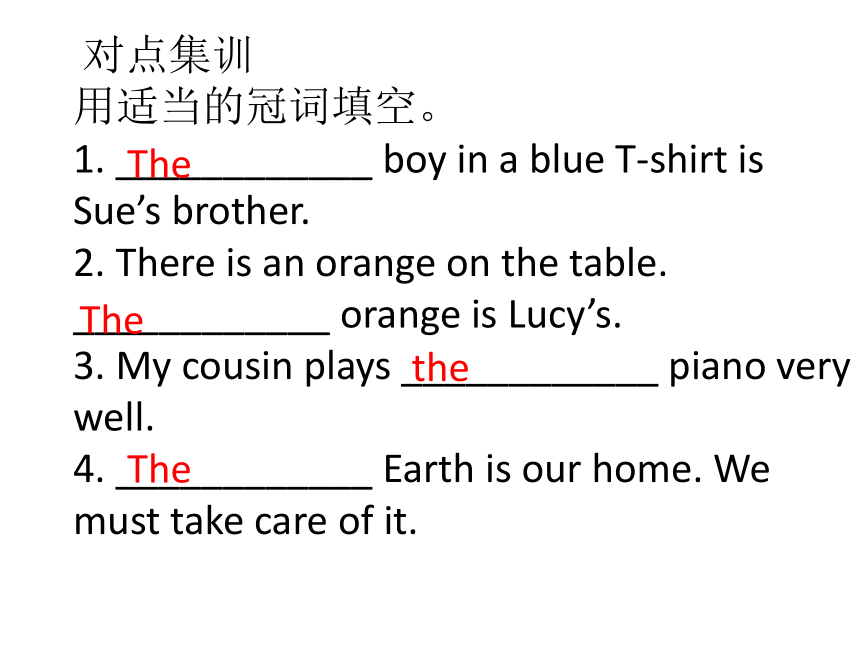
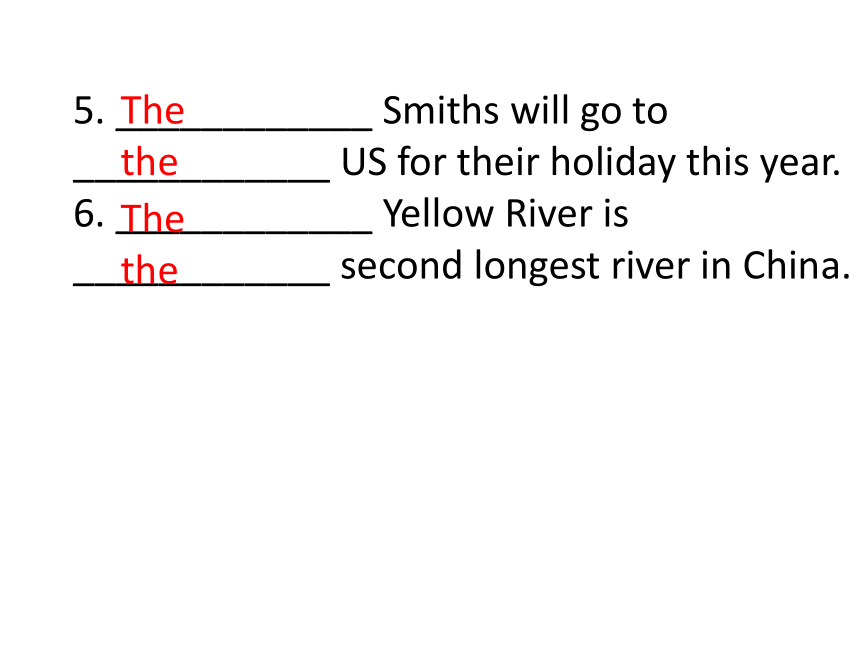
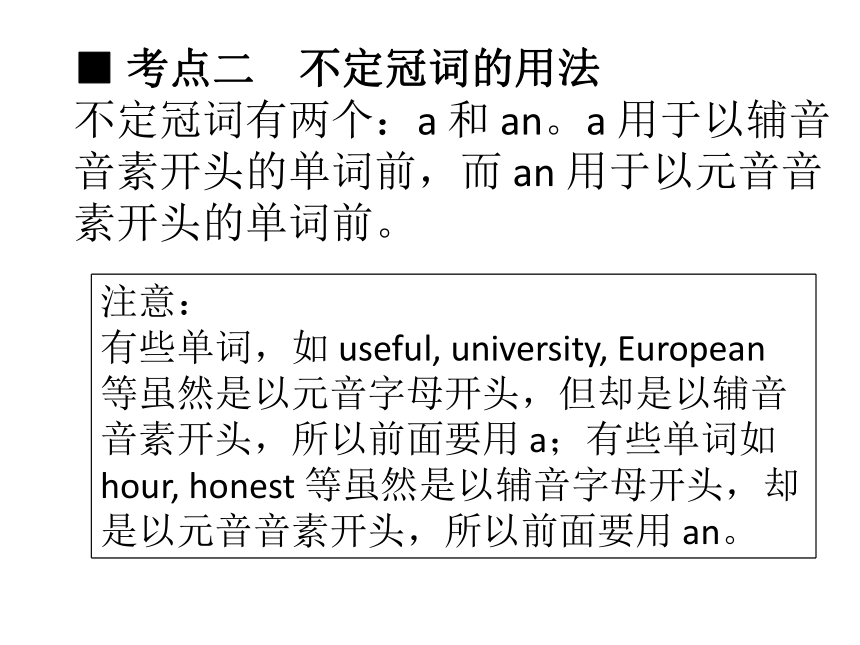
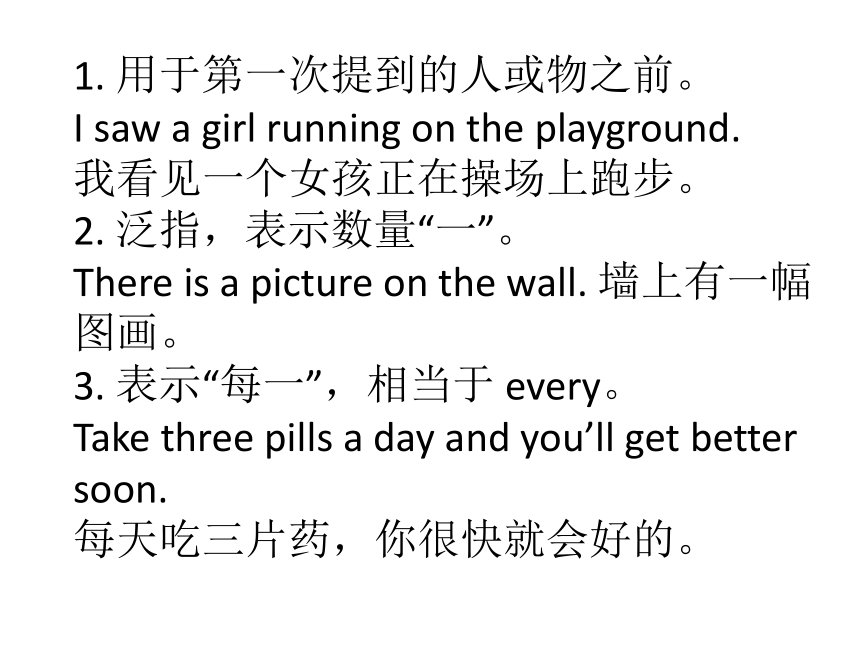
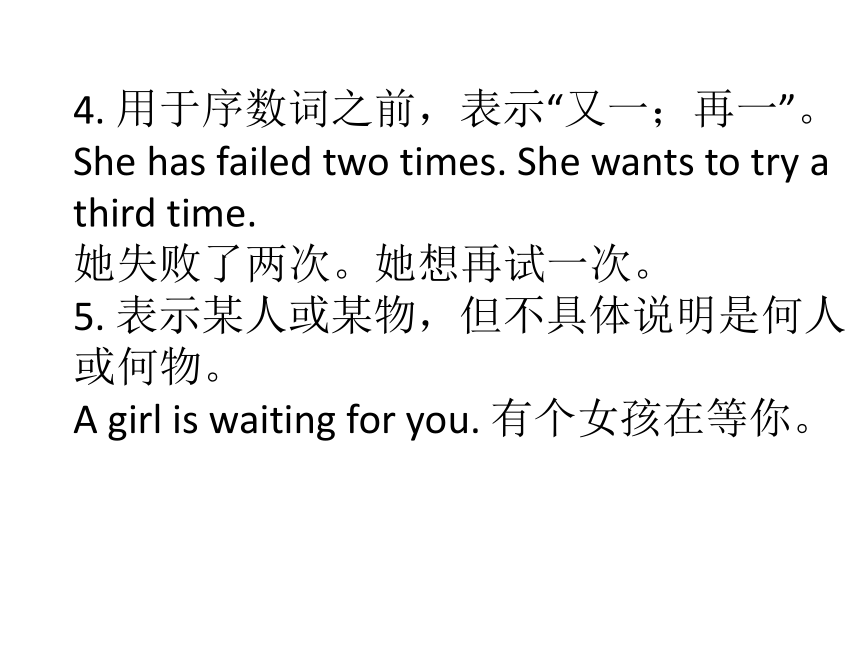
文档简介
(共35张PPT)
中考英语语法归纳
冠词
九年级英语备课组
■ 考点一 定冠词的用法
定冠词表示特指,指特定的人或物,它与可数名词或不可数名词都能连用。
1. 表示特指的人或物。
Is this the book that you are looking for
这就是你正在找的书吗?
2. 表示双方都知道的人或物。
Please fill in the form and sign it.
请填写表格并签字。
3. 指上文提到过的人或物。
There was a chair by the window. On the chair sat a young woman with a baby in her arms.
窗户旁有一张椅子。椅子上坐着一个年轻的妇女,怀里抱着一个婴儿。
4. 用在世界上独一无二的事物前。
The Earth moves around the sun.
地球围绕着太阳转。
5. 用在序数词前、表示方位的名词前和形容词最高级前。
It’s the second country they will visit in Asia.
这是他们在亚洲要游览的第二个国家。
Beijing lies in the north of China.
北京位于中国的北方。
Autumn is the best season in Beijing.
秋天是北京最好的季节。
6. 用在乐器名称前。
He is good at playing the violin.
他擅长拉小提琴。
7. 用在姓氏复数前,表示某某一家人或夫妇俩。
The Taylors were having dinner when I came in.
当我进来时,泰勒一家/泰勒夫妇正在吃晚饭。
8. 用在一些形容词前,表示一类人。
Peace belongs to all people, the poor and the rich.
和平属于所有人,穷人和富人。
9. 用在由普通名词构成的专有名词前。
the Great Wall 长城
the Changjiang River 长江
10. 用在表示某世纪逢十的年代前。
in the 1990s 在20世纪90年代
11. 用在某些固定词组中。
all the time一直
by the way 顺便说一下
巧记:定冠词 the 的用法
特指双方熟悉,上文已经提及;
世上独一无二,方位以及乐器;
某些专有名词,外加复数姓氏;
序数词最高级,习惯用语要特记。
对点集训
用适当的冠词填空。
1. ____________ boy in a blue T-shirt is Sue’s brother.
2. There is an orange on the table. ____________ orange is Lucy’s.
3. My cousin plays ____________ piano very well.
4. ____________ Earth is our home. We must take care of it.
The
The
the
The
5. ____________ Smiths will go to ____________ US for their holiday this year.
6. ____________ Yellow River is ____________ second longest river in China.
The
the
The
the
■ 考点二 不定冠词的用法
不定冠词有两个:a 和 an。a 用于以辅音音素开头的单词前,而 an 用于以元音音素开头的单词前。
注意:
有些单词,如 useful, university, European 等虽然是以元音字母开头,但却是以辅音音素开头,所以前面要用 a;有些单词如 hour, honest 等虽然是以辅音字母开头,却是以元音音素开头,所以前面要用 an。
1. 用于第一次提到的人或物之前。
I saw a girl running on the playground.
我看见一个女孩正在操场上跑步。
2. 泛指,表示数量“一”。
There is a picture on the wall. 墙上有一幅图画。
3. 表示“每一”,相当于 every。
Take three pills a day and you’ll get better soon.
每天吃三片药,你很快就会好的。
4. 用于序数词之前,表示“又一;再一”。
She has failed two times. She wants to try a third time.
她失败了两次。她想再试一次。
5. 表示某人或某物,但不具体说明是何人或何物。
A girl is waiting for you. 有个女孩在等你。
6. 用于某些物质名词、抽象名词等不可数名词前,表示“一个、一种、一次、一份、一场”等含义。
China is a large country with a long history.
中国是一个拥有悠久历史的大国。
The city has a population of ten million.
这座城市有一千万人口。
7. 用于某些固定词组中。
have a good time 玩得高兴
after a while 过一会儿
make a mistake 犯错误
a lot of 许多
巧记:不定冠词 a, an 的用法
冠词 a, an 两种帽,单数可数名词要。
选帽只要听读音,不看字母能做到;
若是元音音素来开头,一定需要选 an 帽;
辅音音素戴 a 帽,记住规律莫乱套。
对点集训
用适当的冠词填空。
1. I want to be _______ engineer some day.
2. Several years ago I studied in _______ university in Shanghai.
3. _______ boy is waiting for you at the school gate.
4. I have _______ English dictionary and it helps me a lot.
5. There is _______ table and four chairs in the room.
an
a
A
an
a
6. I have three books. I want to buy _______ fourth one.
a
■ 考点三 零冠词的用法
1. 在表示人名、地名、国家名等专有名词前通常不用冠词。
China is a great country in the world.
中国是世界上一个伟大的国家。
2. 不可数名词或复数名词表示泛指时不用冠词。
Young people like to read books.
年轻人喜欢读书。
3. 在季节、月份、星期等表示时间的名词前,不加冠词。
January 1st is New Year’s Day. 一月一日是元旦。
注意:
某些不可数名词表示具体意思时,要加冠词。
The meat will be bad if it isn’t kept cool.
肉如果不冷藏会变坏。
4. 在称呼或表示官衔、职位的名词前不加冠词。
Doctor, I’m not feeling myself today.
医生,我今天感觉有些不舒服。
5. 在表示三餐、球类运动和学科的名词前,不加冠词。
What do you usually have for lunch
你午餐通常吃什么?
Do you like playing football or baseball
你喜欢踢足球还是打棒球?
注意:
(1) 三餐名词前有形容词修饰时,应加冠词。
He had a quick breakfast and rushed off to work.
他匆忙吃完早餐,赶紧去上班了。
(2) 球类名词用于指具体物体时,应用冠词。
—Where is the football 那个足球在哪里?
—It’s under the desk. 它在书桌下面。
6. 当 by 与交通工具连用表示一种方式时,中间无冠词。
Did you go there by plane or by ship
你是乘飞机还是乘轮船去的那里?
注意:
交通工具名词不与 by 连用时,其前要加冠词。
Do they take the bus to school
他们乘公共汽车去上学吗?
7. 名词前面有物主代词、指示代词、不定代词或名词的所有格修饰时,前面不用冠词。
His book is on the desk. 他的书在桌子上。
巧记:零冠词的用法
下列情况不用冠,名词之前代词限。
复数名词表泛指,球类学科和三餐。
专有名词不可数,星期月份季节前。
交通方式和娱乐,习语称谓和头衔。
对点集训
用 a、an、the 或“/”填空。
1. I have _______ brother and two sisters.
2. Jack likes playing _______ basketball very much.
3. In the US, Father’s Day falls in _______ June.
4. We’ll go to Wuhan by _______ train tomorrow.
5. There is no living thing on _______ moon.
6. John has _______ breakfast at six o’clock every morning.
a
/
/
/
the
/
■ 考点四 常见含有冠词及不含冠词的词组
1. 常见含有冠词的词组
(1) 常见含有不定冠词的词组
a little/few/bit; have a look/rest/cold/fever; have a good time; in a hurry; a lot of; have a great time; a number of; make a decision; make a living; make a face; make a mistake; in a word; take a bus/train/plane
(2) 常见含有定冠词的词组
in the daytime; in the morning / afternoon / evening; in the middle of; in the end; in the open air; by the way; by the end of; at the beginning of; at the same time; at the moment; on the other side of; on the right / left
2. 常见不含冠词的词组
at first/last; at home/school/work; at noon/night; all day and all night; in danger; in fact; in time; on time; on foot; watch TV; (stay/be) in bed; go to school/work/bed
3. 有无冠词的几个注意点:
(1) 单数名词前面加冠词或不定冠词以及复数名词前不用冠词都可表示某一类。
A dog is a useful animal. = The dog is a useful animal. = Dogs are useful animals.
狗是有用的动物。
(2) 某些固定短语中有无定冠词的区别:
无定冠词 有定冠词
at table 在吃饭 at the table 在桌子旁边
(不一定在吃饭)
at/in school 在上学 at/in the school 在学校里
(不一定是学生)
by sea 乘船 by the sea 在海边
go to bed 上床睡觉 go to the bed 走到床边
(不一定是去睡觉)
in bed(睡、病、 躺)在床上 in the bed 在床上
in class 在课堂上 in the class 在班级里
in front of 在(外部的)前面 in the front of
在(内部的)前面
in hospital (生病)住院 in the hospital
在医院里(不一定在住院)
on earth 究竟 on the Earth 在地球上
对点集训
用 a、an、the 或“/”填空。
1. In _______ fact, I know little about her.
2. I don’t think it’s _______ interesting book.
3. I usually go to _______ bed at 9 o’clock in _______ evening.
4. There is a desk in _______ front of the classroom.
5. —What’s _______ matter with you
—I have _______ toothache.
/
an
/
the
the
the
a
6. We all had _______ good time in the White Clouds Hill yesterday.
a
■ 考点五 冠词的位置
1. 定冠词的位置
(1) 定冠词通常置于名词前,当名词前有形容词修饰时,定冠词应放在形容词之前。
The new book is worth reading.
这本新书值得一看。
(2) 当定冠词与 all, half, both, double 等词连用修饰名词时,定冠词应置于这些词之后。
Of all the girls she sings best.
在所有女孩子中她唱得最好。
(3) 当定冠词与表示倍数、分数的词连用时,定冠词要置于这些词之后。
Your room is twice the size of mine.
你的房间是我的房间的两倍大。
2. 不定冠词的位置
(1) 通常情况下,不定冠词放在名词之前。
There is a book on the floor.
地板上有一本书。
(2) 当名词前有形容词修饰时,不定冠词一般放在形容词之前。
It’s a long way from here.
离这里有一段很长的路。
(3) 当名词前的形容词被 so, how, as
等副词修饰时,不定冠词要放在形容词和名词中间。
I’ve never seen so nice a film.
我从来没有看过如此好的电影。
(4) 当单数名词被 such, what, many 等修饰时,不定冠词要放在这些词之后。
He is such a clever boy that we all like him.
他是一个如此聪明的男孩,我们都喜欢他。
What a wonderful painting!
多么美的一幅油画!
(5) 当单数名词前有形容词和 quite, rather, very 修饰时,不定冠词要置于 quite 或 rather 之后,very 之前。
He is quite a clever boy.
他是一个相当聪明的男孩子。
He is a very clever boy.
他是一个很聪明的男孩子。
中考英语语法归纳
冠词
九年级英语备课组
■ 考点一 定冠词的用法
定冠词表示特指,指特定的人或物,它与可数名词或不可数名词都能连用。
1. 表示特指的人或物。
Is this the book that you are looking for
这就是你正在找的书吗?
2. 表示双方都知道的人或物。
Please fill in the form and sign it.
请填写表格并签字。
3. 指上文提到过的人或物。
There was a chair by the window. On the chair sat a young woman with a baby in her arms.
窗户旁有一张椅子。椅子上坐着一个年轻的妇女,怀里抱着一个婴儿。
4. 用在世界上独一无二的事物前。
The Earth moves around the sun.
地球围绕着太阳转。
5. 用在序数词前、表示方位的名词前和形容词最高级前。
It’s the second country they will visit in Asia.
这是他们在亚洲要游览的第二个国家。
Beijing lies in the north of China.
北京位于中国的北方。
Autumn is the best season in Beijing.
秋天是北京最好的季节。
6. 用在乐器名称前。
He is good at playing the violin.
他擅长拉小提琴。
7. 用在姓氏复数前,表示某某一家人或夫妇俩。
The Taylors were having dinner when I came in.
当我进来时,泰勒一家/泰勒夫妇正在吃晚饭。
8. 用在一些形容词前,表示一类人。
Peace belongs to all people, the poor and the rich.
和平属于所有人,穷人和富人。
9. 用在由普通名词构成的专有名词前。
the Great Wall 长城
the Changjiang River 长江
10. 用在表示某世纪逢十的年代前。
in the 1990s 在20世纪90年代
11. 用在某些固定词组中。
all the time一直
by the way 顺便说一下
巧记:定冠词 the 的用法
特指双方熟悉,上文已经提及;
世上独一无二,方位以及乐器;
某些专有名词,外加复数姓氏;
序数词最高级,习惯用语要特记。
对点集训
用适当的冠词填空。
1. ____________ boy in a blue T-shirt is Sue’s brother.
2. There is an orange on the table. ____________ orange is Lucy’s.
3. My cousin plays ____________ piano very well.
4. ____________ Earth is our home. We must take care of it.
The
The
the
The
5. ____________ Smiths will go to ____________ US for their holiday this year.
6. ____________ Yellow River is ____________ second longest river in China.
The
the
The
the
■ 考点二 不定冠词的用法
不定冠词有两个:a 和 an。a 用于以辅音音素开头的单词前,而 an 用于以元音音素开头的单词前。
注意:
有些单词,如 useful, university, European 等虽然是以元音字母开头,但却是以辅音音素开头,所以前面要用 a;有些单词如 hour, honest 等虽然是以辅音字母开头,却是以元音音素开头,所以前面要用 an。
1. 用于第一次提到的人或物之前。
I saw a girl running on the playground.
我看见一个女孩正在操场上跑步。
2. 泛指,表示数量“一”。
There is a picture on the wall. 墙上有一幅图画。
3. 表示“每一”,相当于 every。
Take three pills a day and you’ll get better soon.
每天吃三片药,你很快就会好的。
4. 用于序数词之前,表示“又一;再一”。
She has failed two times. She wants to try a third time.
她失败了两次。她想再试一次。
5. 表示某人或某物,但不具体说明是何人或何物。
A girl is waiting for you. 有个女孩在等你。
6. 用于某些物质名词、抽象名词等不可数名词前,表示“一个、一种、一次、一份、一场”等含义。
China is a large country with a long history.
中国是一个拥有悠久历史的大国。
The city has a population of ten million.
这座城市有一千万人口。
7. 用于某些固定词组中。
have a good time 玩得高兴
after a while 过一会儿
make a mistake 犯错误
a lot of 许多
巧记:不定冠词 a, an 的用法
冠词 a, an 两种帽,单数可数名词要。
选帽只要听读音,不看字母能做到;
若是元音音素来开头,一定需要选 an 帽;
辅音音素戴 a 帽,记住规律莫乱套。
对点集训
用适当的冠词填空。
1. I want to be _______ engineer some day.
2. Several years ago I studied in _______ university in Shanghai.
3. _______ boy is waiting for you at the school gate.
4. I have _______ English dictionary and it helps me a lot.
5. There is _______ table and four chairs in the room.
an
a
A
an
a
6. I have three books. I want to buy _______ fourth one.
a
■ 考点三 零冠词的用法
1. 在表示人名、地名、国家名等专有名词前通常不用冠词。
China is a great country in the world.
中国是世界上一个伟大的国家。
2. 不可数名词或复数名词表示泛指时不用冠词。
Young people like to read books.
年轻人喜欢读书。
3. 在季节、月份、星期等表示时间的名词前,不加冠词。
January 1st is New Year’s Day. 一月一日是元旦。
注意:
某些不可数名词表示具体意思时,要加冠词。
The meat will be bad if it isn’t kept cool.
肉如果不冷藏会变坏。
4. 在称呼或表示官衔、职位的名词前不加冠词。
Doctor, I’m not feeling myself today.
医生,我今天感觉有些不舒服。
5. 在表示三餐、球类运动和学科的名词前,不加冠词。
What do you usually have for lunch
你午餐通常吃什么?
Do you like playing football or baseball
你喜欢踢足球还是打棒球?
注意:
(1) 三餐名词前有形容词修饰时,应加冠词。
He had a quick breakfast and rushed off to work.
他匆忙吃完早餐,赶紧去上班了。
(2) 球类名词用于指具体物体时,应用冠词。
—Where is the football 那个足球在哪里?
—It’s under the desk. 它在书桌下面。
6. 当 by 与交通工具连用表示一种方式时,中间无冠词。
Did you go there by plane or by ship
你是乘飞机还是乘轮船去的那里?
注意:
交通工具名词不与 by 连用时,其前要加冠词。
Do they take the bus to school
他们乘公共汽车去上学吗?
7. 名词前面有物主代词、指示代词、不定代词或名词的所有格修饰时,前面不用冠词。
His book is on the desk. 他的书在桌子上。
巧记:零冠词的用法
下列情况不用冠,名词之前代词限。
复数名词表泛指,球类学科和三餐。
专有名词不可数,星期月份季节前。
交通方式和娱乐,习语称谓和头衔。
对点集训
用 a、an、the 或“/”填空。
1. I have _______ brother and two sisters.
2. Jack likes playing _______ basketball very much.
3. In the US, Father’s Day falls in _______ June.
4. We’ll go to Wuhan by _______ train tomorrow.
5. There is no living thing on _______ moon.
6. John has _______ breakfast at six o’clock every morning.
a
/
/
/
the
/
■ 考点四 常见含有冠词及不含冠词的词组
1. 常见含有冠词的词组
(1) 常见含有不定冠词的词组
a little/few/bit; have a look/rest/cold/fever; have a good time; in a hurry; a lot of; have a great time; a number of; make a decision; make a living; make a face; make a mistake; in a word; take a bus/train/plane
(2) 常见含有定冠词的词组
in the daytime; in the morning / afternoon / evening; in the middle of; in the end; in the open air; by the way; by the end of; at the beginning of; at the same time; at the moment; on the other side of; on the right / left
2. 常见不含冠词的词组
at first/last; at home/school/work; at noon/night; all day and all night; in danger; in fact; in time; on time; on foot; watch TV; (stay/be) in bed; go to school/work/bed
3. 有无冠词的几个注意点:
(1) 单数名词前面加冠词或不定冠词以及复数名词前不用冠词都可表示某一类。
A dog is a useful animal. = The dog is a useful animal. = Dogs are useful animals.
狗是有用的动物。
(2) 某些固定短语中有无定冠词的区别:
无定冠词 有定冠词
at table 在吃饭 at the table 在桌子旁边
(不一定在吃饭)
at/in school 在上学 at/in the school 在学校里
(不一定是学生)
by sea 乘船 by the sea 在海边
go to bed 上床睡觉 go to the bed 走到床边
(不一定是去睡觉)
in bed(睡、病、 躺)在床上 in the bed 在床上
in class 在课堂上 in the class 在班级里
in front of 在(外部的)前面 in the front of
在(内部的)前面
in hospital (生病)住院 in the hospital
在医院里(不一定在住院)
on earth 究竟 on the Earth 在地球上
对点集训
用 a、an、the 或“/”填空。
1. In _______ fact, I know little about her.
2. I don’t think it’s _______ interesting book.
3. I usually go to _______ bed at 9 o’clock in _______ evening.
4. There is a desk in _______ front of the classroom.
5. —What’s _______ matter with you
—I have _______ toothache.
/
an
/
the
the
the
a
6. We all had _______ good time in the White Clouds Hill yesterday.
a
■ 考点五 冠词的位置
1. 定冠词的位置
(1) 定冠词通常置于名词前,当名词前有形容词修饰时,定冠词应放在形容词之前。
The new book is worth reading.
这本新书值得一看。
(2) 当定冠词与 all, half, both, double 等词连用修饰名词时,定冠词应置于这些词之后。
Of all the girls she sings best.
在所有女孩子中她唱得最好。
(3) 当定冠词与表示倍数、分数的词连用时,定冠词要置于这些词之后。
Your room is twice the size of mine.
你的房间是我的房间的两倍大。
2. 不定冠词的位置
(1) 通常情况下,不定冠词放在名词之前。
There is a book on the floor.
地板上有一本书。
(2) 当名词前有形容词修饰时,不定冠词一般放在形容词之前。
It’s a long way from here.
离这里有一段很长的路。
(3) 当名词前的形容词被 so, how, as
等副词修饰时,不定冠词要放在形容词和名词中间。
I’ve never seen so nice a film.
我从来没有看过如此好的电影。
(4) 当单数名词被 such, what, many 等修饰时,不定冠词要放在这些词之后。
He is such a clever boy that we all like him.
他是一个如此聪明的男孩,我们都喜欢他。
What a wonderful painting!
多么美的一幅油画!
(5) 当单数名词前有形容词和 quite, rather, very 修饰时,不定冠词要置于 quite 或 rather 之后,very 之前。
He is quite a clever boy.
他是一个相当聪明的男孩子。
He is a very clever boy.
他是一个很聪明的男孩子。
同课章节目录
- 词法
- 名词
- 动词和动词短语
- 动词语态
- 动词时态
- 助动词和情态动词
- 非谓语动词
- 冠词
- 代词
- 数词和量词
- 形容词副词及其比较等级
- 介词和介词短语
- 连词和感叹词
- 构词法
- 相似、相近词比较
- 句法
- 陈述句
- 一般疑问句和否定疑问句
- 特殊疑问句及选择疑问句
- 反意疑问句
- 存在句(There be句型)
- 宾语从句
- 定语从句
- 状语从句
- 主谓一致问题
- 简单句
- 并列句
- 复合句
- 主谓一致
- 主、表语从句
- 名词性从句
- 直接引语和间接引语
- 虚拟语气
- 感叹句
- 强调句
- 倒装句
- 祈使句
- 句子的成分
- 句子的分类
- 题型专区
- 单项选择部分
- 易错题
- 完形填空
- 阅读理解
- 词汇练习
- 听说训练
- 句型转换
- 补全对话
- 短文改错
- 翻译
- 书面表达
- 任务型阅读
- 语法填空
- 其他资料
